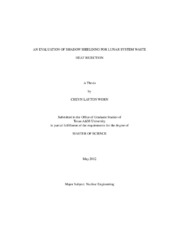| dc.contributor.advisor | Tsvetkov, Pavel V. | |
| dc.creator | Worn, Cheyn | |
| dc.date.accessioned | 2012-07-16T15:58:49Z | |
| dc.date.accessioned | 2012-07-16T20:29:30Z | |
| dc.date.available | 2014-09-16T07:28:20Z | |
| dc.date.created | 2012-05 | |
| dc.date.issued | 2012-07-16 | |
| dc.date.submitted | May 2012 | |
| dc.identifier.uri | https://hdl.handle.net/1969.1/ETD-TAMU-2012-05-11202 | |
| dc.description.abstract | Shadow shielding is a novel and practical concept for waste heat rejection from lunar surface spacecraft systems. A shadow shield is a light shield that shades the radiator from parasitic thermal radiation emanating from the sun or lunar surface. Radiator size and mass can reduce if the radiator is not required to account for parasitic heat loads in addition to system energy rejection requirements. The lunar thermal environment can be very harsh towards radiative heat rejection. Parasitic heat loads force the radiator to expand in size and mass to compensate. On the Moon, there are three types: surface infrared, solar insulation, and albedo. This thesis tests shadow shielding geometry and its effect on the radiator and nuclear reactor in a reactor-powered Carnot heat engine. Due to the nature of cooling by radiative heat transfer, the maximum shaft work a Carnot system can produce and the minimal required radiator area occurs when the Carnot efficiency is 25%.
First, a case for shadow shielding is made using an isothermal, control radiator model in Thermal Desktop. Six radiator temperatures and three latitudes are considered in the tests. Test variables in this section include radiator shapes and shade geometry. The simulations found that shadow shielding is best suited for a low-temperature radiator at the lunar equator. Optimized parabolic shade geometry includes a focus right above or at the top of the radiator and full to three-quarters shade height. The most useful rectangular radiator shape for shadow shielding is that which has a low height and long width.
All simulations were conducted using a shade with a 10 kg/m2 area mass. A sensitivity study was conducted for different shade area masses using high and low values found in the literature. The shade is the most useful when the shade's area mass is less than or equal to that of the radiator. If the shade mass is below this threshold, the shade would be applicable to all radiator temperatures tested.
Optimized shade and radiator geometry results were then factored into a second model where the radiator is comprised of heat pipes which is similar to radiators from actual system designs. Further simulations were conducted implementing the SAFE-4001 fast fission nuclear reactor design. The study found that shadow shielding allowed the system to use a low-temperature radiator where other configurations were not viable because shadow shielding drastically improves radiative heat transfer from the radiator, but at the consequence of raising radiator mass. | en |
| dc.format.mimetype | application/pdf | |
| dc.language.iso | en_US | |
| dc.subject | Space Nuclear Systems | en |
| dc.subject | Heat Radiators | en |
| dc.subject | Thermal Analysis | en |
| dc.subject | Parabolic Shadow Shielding | en |
| dc.subject | Lunar Thermal Environment | en |
| dc.subject | SAFE-400 | en |
| dc.subject | Radiative Heat Transfer | en |
| dc.subject | Carnot Cycle | en |
| dc.title | An Evaluation of Shadow Shielding for Lunar System Waste Heat Rejection | en |
| dc.type | Thesis | en |
| thesis.degree.department | Nuclear Engineering | en |
| thesis.degree.discipline | Nuclear Engineering | en |
| thesis.degree.grantor | Texas A&M University | en |
| thesis.degree.name | Master of Science | en |
| thesis.degree.level | Masters | en |
| dc.contributor.committeeMember | Hassan, Yassin A. | |
| dc.contributor.committeeMember | Jacobs, Tim J. | |
| dc.contributor.committeeMember | Bragg-Sitton, Shannon M. | |
| dc.type.genre | thesis | en |
| dc.type.material | text | en |
| local.embargo.terms | 2014-07-16 | |


